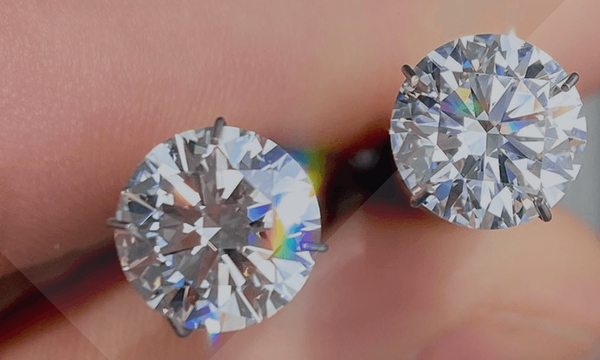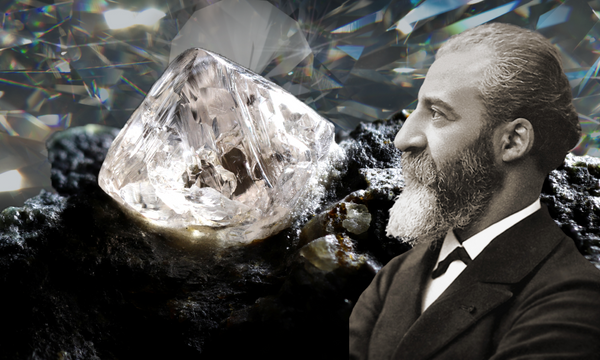Lab-grown diamonds and lab-grown moissanite are both popular choices for those seeking alternative gemstones other than natural gemstones, other synthetics, and earth-mined diamonds for their jewelry.
Lab grown diamonds vs moissanite; this blog post will cover the differences between the two stones, analyzing similarities and visually appearance of both lab-grown diamonds and lab-grown moissanite. Choosing your moissanite chain, ring, and other moissanite jewelry is fun and rewarding—learning about moissanite makes it all the more meaningful.
What are Lab-Grown Diamonds?

Lab-grown diamonds are identical to natural earth-mined diamonds, created in a lab. Lab-grown diamonds exhibit all the optical and chemical properties of natural diamonds. Lab-grown diamonds are the synthetic alternative to diamonds without the environmental risks, forced labor sometimes associated with natural diamonds and sourcing the diamonds.
How are Lab-Grown Diamonds Created
Lab-grown diamonds are chemically and structurally identical to natural diamonds. Lab-grown diamonds are created using advanced technology replicating the conditions of natural diamonds formed in the earth's crust–only in a controlled environment under supervision.
Lab-grown diamonds are created through two different processes. These processes include a chemical vapor deposition (CVD) or the high-pressure, high-temperature (HPHT) method. Both the CVD and HPHT methods produce gem-ready, high-quality lab-grown diamonds with the same chemical and physical properties as natural diamonds.
What is a Moissanite?
Moissanite is a gemstone discovered in Arizona in 1893 by French chemist Henri Moissan, hence its name moissanite. Moissanite is known for its exceptional brilliance and fire, which refers to its ability to reflect and refract light.

Because natural moissanite is so rare, scientists discovered a way to reproduce moissanite at a fraction of the cost for the consumer. Charles & Colvard, a gemstone and jewelry manufacturer, pioneered the production of synthetic moissanite in the 1990s. This made moissanite rise in popularity, providing a fantastic alternative to natural moissanite, natural diamonds, and mined gemstones.
Lab-grown and synthetic moissanite is one of the hardest-known gemstones, ranking 9.25 on the Mohs scale of hardness. While it is not as hard as a natural or lab-grown diamond, it is still highly durable and resistant to scratches and abrasions, making it suitable for everyday wear.
How is Moissanite Created
The Lely process or Lely method is used to create large silicon carbide crystals for the formation of man-made moissanite. Production of silicon carbide crystals features a combination of high-purity silicon with carbon and heating the mixture in an inert atmosphere. The moissanite crystals are then fashioned, cut, and faceted into different sizes, shapes, and carats, making them ready for setting into jewelry or sold as loose stones.
Natural moissanite is found in kimberlites, lamproites, and meteorites, and only in small quantities. Lab-created moissanite has made it more available to a worldwide audience, perfect for those who appreciate this incredible gemstone from the galaxy.
Key Differences Between Lab-Grown Diamonds and Lab-Grown Moissanite

The following are some key differences behind these beautifully brilliant and socially-conscious natural diamond alternatives:
Sparkle and Appearance: Lab-grown diamonds have identical physical and chemical properties as natural diamonds, resulting in a gorgeous sparkle and glamorous appearance. They exhibit exceptional brilliance, fire, and scintillation, which are key factors that make diamonds so sought-after, popular, and timeless.
Moissanite has distinctive sparkle and appearance characteristics, setting it apart from natural and lab-grown diamonds. Since moissanite has such a high refractive index, it results in a different type of brilliance than a diamond's icy white, often described as a "disco ball" effect or a rainbow sparkle. Moissanite exhibits a breathtakingly colorful appearance, making it a stand-out stone.
Composition: Diamond is the only gem made of a single element. Diamonds are composed of 99.95 percent carbon. Moissanite is composed of silicon carbide (SiC).
Color Quality: Lab-grown diamond and moissanite come in different shapes, sizes, carats, and qualities, evaluated on the GIA’s 4Cs grading scale. The 4Cs include cut, color, clarity and carat and are a universal way of understanding the stones value and appearance. Lab-grown diamonds and moissanite also come in fancy colors with trace elements in a lab. These colors result in green, pink, blue, yellow, and more.
Clarity: Moissanite and diamond are graded according to the quality scale. This scale evaluates growth characteristics (inclusions) and blemishes (exterior imperfections). The clarity scale ranges from F (flawless) to I3 (heavily included. The scale is as follows:
F: Flawless
IF: Internally Flawless
VVS1-VVS2: Very Very Slightly Included
VS1-VS2: Very Slightly Included
SI1-SI2: Slightly Included
I1-I2: Included
I3: Heavily Included
Moissanite is almost always free of inclusions with no eye-visible imperfections. Lab-grown diamonds may be anywhere on the scale.
Price: Moissanite is more affordable than lab-grown diamonds when all quality factors and carat weight are equal. The price may be due to the difference in the production processes and market demand (popularity). Comparing prices from sources and consulting with professional jewelers will assist in choosing the best pricing for moissanite and lab-grown diamonds for your jewelry purchase.
Refraction: Stones are evaluated on the refractive index scale, a useful way of measuring how much light travels through the mineral. Moissanite has a refractive index ranging from 2.648 to 2.691 with a dispersion of 0.104, contributing to its ability to disperse light (dispersion) into a stunning rainbow spectrum of colors. Dispersion is when white light enters a gemstone, scattering into rainbow-colored light. Moissanite has an adamantine luster, making it exceptionally brilliant. Diamond has a refractive index of 2.42 and a dispersion of 0.044, making it not quite as brilliant as moissanite–moissanite is actually known as the world’s most brilliant gemstone!
Ethics and Sustainability:
Here are some factors to consider with lab-grown diamonds and moissanite related to ethics and sustainability:
Ethical Sourcing: Moissanite and lab-grown diamonds are both created in controlled laboratory environments. The lab process does not involve mining, avoiding potential ethical concerns associated with diamond mining, such as human rights violations, harsh labor conditions, and environmental damage.
Conflict-Free: Moissanite and lab-grown diamonds are inherently conflict-free since they are created in a lab. Lab-grown diamonds and moissanite are not associated with regions known for unethical practices used for diamond sourcing and extraction.
Sustainability: The production of moissanite and lab-grown diamonds requires energy and resources for technology, work force, and materials, but has little to no environmental impact compared to natural, earth-mined diamond and gemstone mining.
Socially Conscious: Feel good wearing your lab-grown diamond or moissanite because of their man-made origin.
Differences in Hardness, Durability, and Scratch Resistance
The Mohs scale (pronounced MOZE) rates the hardness of gems and minerals according to their scratch-resistant tendencies. This scale was developed by Friedrich Mohs in 1822, hence the name.
According to the Gemological Institute of America (GIA), the hardness of a mineral refers to how resistant it is to scratching, or how its surface responds when it comes into contact with a sharp point. It is important to note that hardness should not be confused with toughness, which refers to how well a gem resists breaking, chipping, or cracking.
The scale rates objects from 1-10. Diamond is famous for its hardness or scratch resistant tendencies, rating a 10 out of 10. Moissanite rates a 9.25, making it almost as scratch resistant as a diamond.
Both lab grown diamonds and moissanite are perfect for wearing daily because of their durability. Interested in learning how other diamond alternatives stack up? Check out our blog, White Sapphire vs. Moissanite: Pros, Cons, and Differences for more information.
So Which is Better, Lab-Grown Diamonds vs Moissanite?
The choice between lab-grown diamonds and moissanite depends on your personal preferences and budget options. Here are some factors to consider when comparing the two:
Aesthetics: Lab-grown diamonds are chemically and structurally identical to natural diamonds, while moissanite is composed of silicon carbide, making them two totally different gemstones--not even related. If you prefer a natural diamond in terms of its composition and appearance, lab-grown diamonds offer the best alternative. If you appreciate the show-stopping rainbow sparkle of moissanite, it may be more appealing to you.
Hardness and Durability: Lab-grown diamonds rate 10 on the Mohs scale of hardness, making them the hardest known mineral that is highly scratch-resistant. Moissanite rates 9.25 on the Mohs scale, which is also very durable but slightly less hard than diamond. The difference is so slim, the choice is yours.
Factors to Consider
Here are some factors to consider when choosing between a lab-grown diamond and lab-grown moissanite:
Budget: Both lab-grown diamonds and moissanite are graded according to the 4Cs. Lab-grown diamond is typically more expensive than moissanite when all quality factors are equal. What is your budget? How much do you want to spend?
Rarity and Uniqueness: Neither lab-grown moissanite lab-grown diamonds are rare since they are grown in a controlled environment and are synthetic stones. If you are seeking something unique, moissanite is a better option because of its rainbow color spectrum as it sparkles on the finger. Lab-grown diamonds mimic natural diamonds, perfect for those who seek timeless glamor and sophistication.
Ethical and Environmental Considerations: Both lab-grown diamonds and lab-grown diamonds are socially conscious and ethical choices compared to some of the milky origins and harsh labor conditions commonly faced when natural diamonds and natural gemstones are sourced from the earth. Lab-grown diamond alternatives present a world of possibilities that are eco-friendly, high-quality, beautiful, and budget-friendly without disrupting the environment or subjecting people to forced labor conditions.
Purpose: Do you want something equal to a natural diamond or something unique and different? Both lab-grown moissanite and lab-grown diamond have distinctive optical and chemical properties.
Personal Preferences: lab grown diamonds vs moissanite; at first sight, moissanite and diamond may be mistaken for each other. Which do you personally prefer? Being proud and adoring your purchase will ensure you made the right decision. Shop our moissanite chains, custom made moissanite jewelry, and bracelets today for a large selection in fine design.
Who Should Pick Moissanite?
If you are drawn to moissanite's unique beauty, affordability, sustainability, and ethical attributes, moissanite may be an excellent choice for you. Moissanite is available in various qualities, shapes, sizes, and carats, making customizing your dream engagement ring or other jewelry design well within your budget.
Who Should Pick Lab-Grown Diamonds?
Lab-grown diamonds have the same chemical and optical properties as natural diamonds, exhibiting its trademark brilliance, incredible fire, and icey sparkle, offering the same beauty and visual appeal as their natural counterpart at a fraction of the price. Lab-grown diamonds may hold the same emotional value as natural diamonds because diamonds remain the "most sought-after precious gemstone."
Is Moissanite a Suitable Alternative to Lab-Grown Diamonds?

Moissanite is the perfect alternative to lab-grown diamonds for those who want even more brilliance with big, bold look synonyms with moissanite. Ultra-glamorous and made to get noticed, lab-grown moissanite is a high-quality, gorgeous, and brilliant choice instead of lab-grown diamonds for those desiring something different yet sophisticated and timeless.
Frequently Asked Questions
Have questions? Here are some concerns addressed in this article:
Are lab-grown diamonds and moissanite visually similar to natural diamonds?
Moissanite possesses distinct characteristics, setting it apart from natural diamonds, lab-grown diamonds, and all other gemstones. Moissanite has a high refractive index, double refractivity, and exceptional dispersion, making it instantly recognizable to the trained eye. These qualities make moissanite strikingly different from traditional diamonds. Have intense fire and sparkle at a budget-friendly price-point without losing out on quality and durability with moissanite.
Can lab-grown diamonds and moissanite be resized?
Do you need a ring resized, a bracelet extended/ made shorter, or other custom work? A professional jeweler can do these things and more with lab-grown diamonds and moissanite set into jewelry. Durable, hard, and able to withstand heat and pressure, your jewelry may be modified by a professional who handles all tools with care.
Which stone has more brilliance, lab-grown diamonds or moissanite?
Moissanite has a higher refractive index and dispersion, making it more brilliant than a diamond. Moissanite is known as the world’s most brilliant gemstone with its show-stopping rainbow sparkle and double refractivity.
Interested in learning more? Check out our blog The Sparkle Factor: Which Moissanite Cut Sparkles the Most? If you love and adore the sparkle and fire of moissanite fashioned into your favorite shape.
Summary
Both lab-created diamonds and moissanite make a great choice for those seeking a high-quality, budget-friendly, beautiful, and timeless diamond alternative for an engagement ring, chain, bracelet, and so much more. Moissanite and lab-grown diamonds are man-made, recreated in a controlled environment, mimicking their natural counterpart.
Lab grown diamonds vs moissanite; it's a personal choice. Lab-grown diamonds and lab-grown moissanite offer affordability, sustainability, and ethical considerations with price points that are more friendly compared to their natural counterparts. Lab-grown diamonds and moissanite are suitable options for those seeking socially conscious, budget-friendly diamond alternatives without the environmental impact and other negative scenarios included in diamond mining and colored stone sourcing

































































